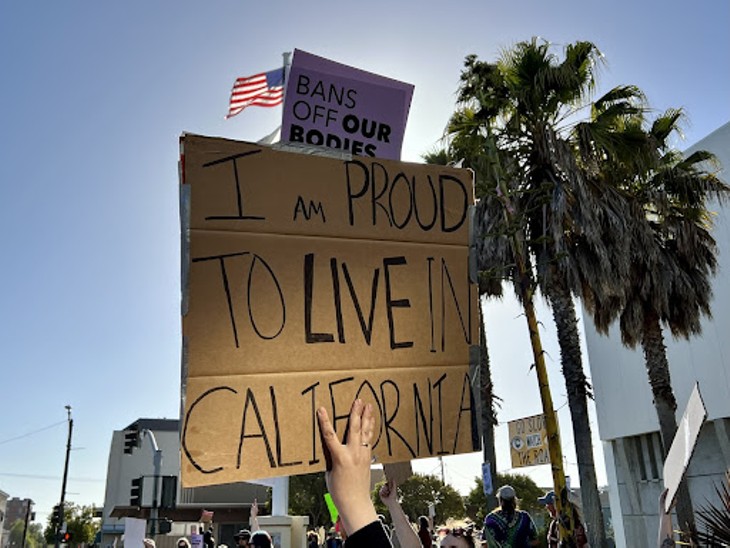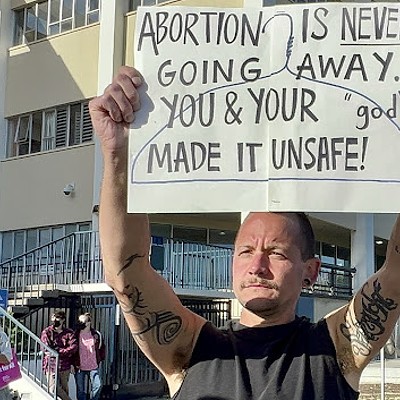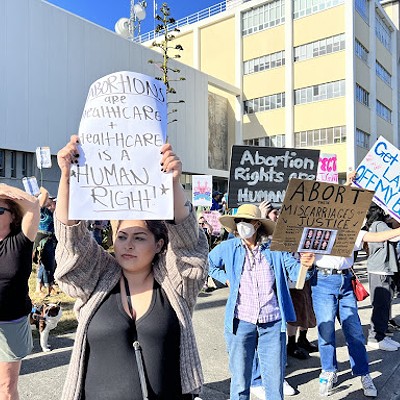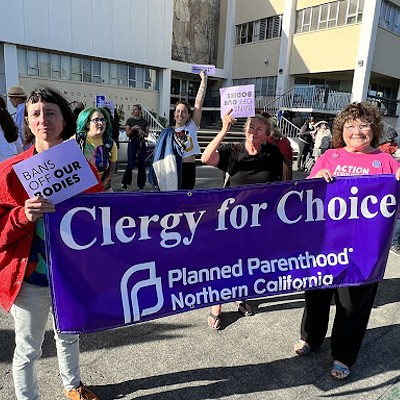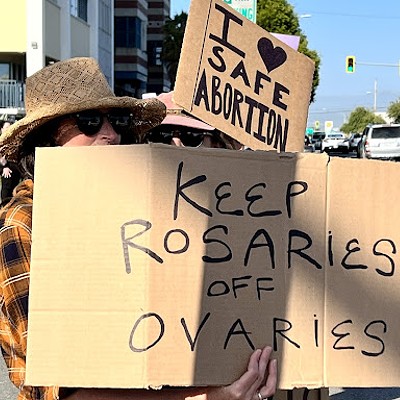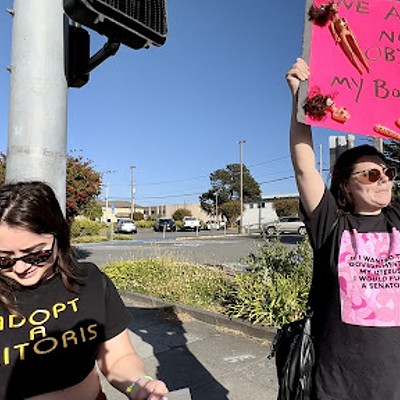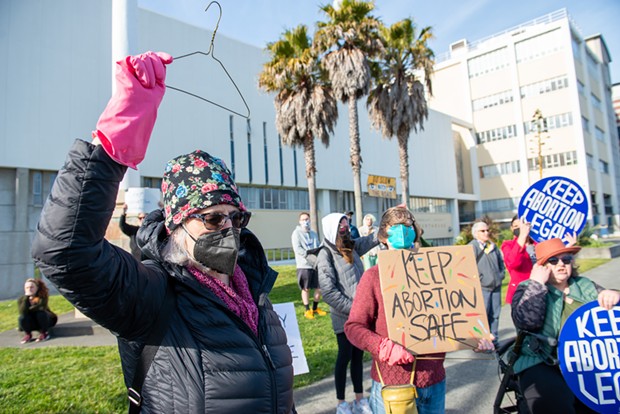Courts
Monday, August 1, 2022
Buckle Up for a Busy Month in Sacramento
Posted By Emily Hoeven, CalMatters on Mon, Aug 1, 2022 at 11:40 AM
Today, state lawmakers will reconvene in Sacramento after a month-long summer recess — during which some traveled abroad on trips funded by special interest groups that lobby them on various issues — for the final, frenzied month of the legislative session.
Legislators face an Aug. 31 deadline to determine the fate of hundreds of bills. Hanging over the high-intensity process is the Nov. 8 general election, which could affect how some lawmakers — especially those vying for contested seats in the state Assembly and Senate — vote on hot-button proposals.
In a preview of the difficult decisions facing lawmakers, hundreds of fast food workers were set to rally at the state Capitol Sunday night in support of a bill that would permit the state to negotiate wages, hours and work conditions for an industry that employs an estimated 700,000 people. A similar measure failed to pass last year.
Thursday, July 21, 2022
Got an Eviction Notice? This California Website Will Help You file a response.
Posted By Manuela Tobias/CalMatters on Thu, Jul 21, 2022 at 12:11 PM
Mora, who blamed his landlord for those issues, tried to file an answer with the court himself but feared a mistake could land him, his wife, and his two young children on the street. He said he paid a lawyer $1,000 to help.
“With one word I could lose the case,” he said in Spanish.
Thousands of California tenants lose their homes every year because they fail to submit that initial answer in court. Failing to check the right box or file a timely response could, indeed, trigger a default judgment against them.
A group of tenant advocates and attorneys today launched a tool they hope will change that.
More than 50 tenant advocates and attorneys from The Debt Collective, The LA Tenants Union, The Anti-Eviction Mapping Project, UCLA Luskin Institute on Inequality & Democracy and the Alliance of Californians for Community Empowerment worked on the “Tenant Power Toolkit” over the last two years — a mostly volunteer effort, explains Hannah Appel, an anthropology professor at UCLA who came up with the idea based on her work as a co-founder of the Debt Collective.
The website they created resembles tax-return-filing software. It asks tenants a long series of questions in relatively plain English, or Spanish, that produces a legal document they can print and submit in court. Tenants in Los Angeles County can file the paperwork electronically. If they choose, tenants can connect to other tenants and legal aid organizations through the website.
The questions vary by eviction type and location. For example, if their city has rent control for people over the age of 65 who lived in the building for five years, the tool will ask tenants for their ages and the time they lived in the building and invoke that defense on paper, even if the tenants didn’t know the protection existed.
Of more than 129,000 eviction cases filed between July 1, 2018 and June 30, 2019, at least 24,000 tenants lost their court cases in a default judgment, according to data from the Judicial Council. That’s 46 percent of cases in courts that reported their outcomes — which most courts don’t do. Default judgements dropped to 7,600, or 40 percent of reported outcomes, last year as a result of statewide eviction protections, which researchers say make that not reflective of a typical year.
“As a lawyer it really pained me to see tenants lose cases just because they couldn’t file a piece of paper,” said UCLA law professor Gary Blasi, one of the lead housing lawyers behind the tool. He called it the first of its kind nationwide.
Friday, July 1, 2022
California Climate Rules Won’t be Undercut by Supreme Court’s Ruling, Experts Say
Posted By Nadia Lopez/CalMatters on Fri, Jul 1, 2022 at 12:56 PM
The 6-3 vote in the West Virginia v. EPA decision marks a significant change in how the federal EPA can exercise power to address climate change, making it clear that without approval from Congress, the agency is limited in how it can set national standards.
The bigger question now is how the ruling could affect the control all federal agencies have in imposing regulations and how states like California – which have historically taken a stronger approach to tackling climate change– could be affected.
California’s Air Resources Board, which oversees the state’s efforts to reduce air pollution, told CalMatters the agency agrees that the state’s policies and regulatory agencies now play an even more critical role in the fight against climate change.
Several experts say the ruling would not cripple the state’s efforts. Still, California’s efforts alone can’t solve a global problem, said attorney Sean Donahue, whose firm Donahue, Goldberg & Littleton wrote a brief in the case.
“California has its own state laws that are regulating carbon dioxide emissions so in that respect, it matters less to California directly,” Donahue said. “However, we’re all affected by climate change. California is doing a lot to try to reduce its own emissions, but we won’t have a safe climate unless everybody pitches in and the federal government’s efforts are really important there.”
The state’s authority to independently set stronger tailpipe emissions standards than those of the federal government was granted half a century ago, when Congress passed the Clean Air Act in 1970. The law included special conditions for California to help the state address its severe smog.
Some experts worry that today’s ruling could lead federal agencies to take a more cautious and less effective approach to addressing major threats to public health and safety.
Thursday, June 30, 2022
County, Paz Dominguez Reach $100k Separation Agreement
Posted By Kimberly Wear on Thu, Jun 30, 2022 at 5:44 PM
A county news release states the county also agrees to pay "reasonable attorney fees" in connection with a lawsuit filed against her by the state and just over $13,000 for legal costs incurred due to a cross-complaint filed by the county.
Cheryl Dillingham, who this month overwhelmingly defeated Paz Dominguez at the ballot box to take over the elected post, will serve until her term officially begins, the county states in the release.
"Should the city of Eureka sue the county and Ms. Paz Dominguez for failure to distribute when due property taxes for Fiscal Year 2021-22, the county will defend and indemnify her in that suit, and any other suit against her arising in the course and scope of her service," the release also notes. "As it relates to this matter, the county is poised to execute a tolling agreement with the anticipation of avoiding litigation."
The agreement is expected to officially come before the Humboldt County Board of Supervisors for final approval July 12, the release states.
A June 2 Humboldt County Grand Jury report found her office's "failure to file timely state and federal reports has already caused the county to lose more than $2.3 million in "non-recoverable funds," while placing more than $9.7 million in funding at "significant risk."
She, meanwhile, has maintained that short staffing and other county departments' sloppy financial management and unwillingness to get her needed records are largely to blame, but county department heads have said the problems lie squarely with her office. (Read more here, here and here.)
Find the county of Humboldt release below and the separation agreement here:
The County of Humboldt today executed a separation agreement with current Auditor-Controller Karen Paz Dominguez stating Ms. Paz Dominguez is resigning effective July 1. Per the Board of Supervisors action on Tuesday, the Board has appointed Auditor-Controller-elect Cheryl Dillingham to serve as interim Auditor-Controller effective upon resignation.
Notable terms of the separation agreement include:
Agreement of Ms. Paz Dominguez to facilitate a smooth transition and cooperate with any appointed Auditor-Controller who succeeds her through Jan. 2, 2023.
Compensation paid to Ms. Paz Dominguez in the amount of $92,368.32, comprised of her salary through Jan. 2, 2023, payments in lieu of insurance benefits, and a flat amount of $15,000.
The county will pay for reasonable attorney fees she incurred related to the State of California’s case (CV 2200584) against Ms. Paz Dominguez and fees of $13,254.85 she incurred with respect to Humboldt Superior Court Case CV 2001430.
The county will dismiss its cross complaint against Ms. Paz Dominguez in the above-referenced State of California case, and will defend and indemnify her in the case.
Should the City of Eureka sue the county and Ms. Paz Dominguez for failure to distribute when due property taxes for Fiscal Year 2021-22, the county will defend and indemnify her in that suit, and any other suit against her arising in the course and scope of her service. As it relates to this matter, the county is poised to execute a tolling agreement with the anticipation of avoiding litigation.
Per the Board’s action, the separation agreement and appointment will return to the Board at its next available meeting, likely July 12, for final approval. Going forward, Ms. Dillingham is scheduled to begin serving next week. The county appreciates Ms. Paz Dominguez’s cooperation with this transition.
Sunday, June 26, 2022
Hundreds Rally for Reproductive Rights in Eureka, Arcata
Posted By Kimberly Wear and Ryan Hutson on Sun, Jun 26, 2022 at 3:30 PM
Until Friday, the 1973 landmark ruling that instilled a constitutional right to abortion, a decision now left to individual states, had been widely considered settled legal precedent.
While safe and legal access to the procedure remains protected in California, the decision threatens "the right to safe and accessible abortion for millions of people nationwide" and will result "in over half our country’s states moving to wipe out abortion access," according to Planned Parenthood Northern California.
"I can’t believe they will give an 18-year-old an A.R. 15 and they will take away women’s right over their own bodies," she said. "It’s not about life, it’s about power over women.”
"Stopping legalized abortion doesn’t stop abortion, it just stops safe abortion," she said. "And it was a sad day for women when this decision came down.”
Matthews took a moment to encourage young people, especially, to get involved in their communities, to vote and to run for office, pledging her help to anyone who was interested.
“You have a voice,” she said. “Please use it.”
The crowd of about 150 then moved to the eastern corners of the square to hold up signs with messages including. “I’m Not Ovary-Acting,” “No Forced Birth” and “Women’s Liberation Now, ”receiving a mostly positive response from passing drivers, many of whom honked and fist pumped their approval, with a view blowing kisses.
There were a few tense moments when a man stopped his large truck in one of the traffic lanes and got into a face-to-face shooting match with at least one of the demonstrators after leaving the vehicle. He then climbed to stand on the top of the truck’s cab until police intervened.
Eureka resident Michelle Huckaby said she was there Sunday to stand up and have her voice heard, especially in solidarity with women in other parts of the country who have now been stripped of their reproductive rights, which are still protected in California.
“Government should not be regulating our bodies,” she said. “It’s our choice. We have more regulations on our bodies than guns. It’s ridiculous. We are mad. … We are not going back.”
Friday, June 24, 2022
Local Protests Planned in Wake of Roe Ruling, Area Representatives Weigh in
Posted By Kimberly Wear on Fri, Jun 24, 2022 at 1:11 PM
A community protest will take place at 5 p.m. today at the Humboldt County Courthouse and another is scheduled for Sunday, from 11 a.m. to 1 p.m., on the Arcata Plaza.
A statement on tonight's rally from Planned Parenthood Northern California states the decision threatens "the right to safe and accessible abortion for millions of people nationwide" and will result "in over half our country’s states moving to wipe out abortion access."
"This would disproportionately harm people who already face systemic discrimination and have limited health care access," the statement reads. "With Roe v. Wade overturned, 26 states have promised to quickly move to ban abortion. Some of these states will move to restrict, ban and/or criminalize abortion immediately. The U. S Supreme Court may have failed to protect our rights, but we are not without power to fight back."
Local representatives also weighed in on ruling that sets aside nearly 50 years of what had been considered settled legal precedent based in the fundamental right to privacy.
“The extreme, out of touch, right-wing Supreme Court has overturned the constitutional right to abortion, tearing apart decades of legal precedent. A cascade of dire consequences and restrictions will now sweep across the country, falling hardest on those who already face the most barriers to care: Black and Brown women, folks who can’t afford care, young people and LGBTQ people, and women suffering domestic violence are now all at the highest risk. This radical conservative court – put into power largely by presidents who lost the popular vote – have now stripped away the freedoms of millions of people in America, putting their health care decisions in the hands of politicians,” North Coast Congressmember Jared Huffman said in a statement.
“This ruling doesn’t change the fact that abortions are health care, and countless women will still need to access it," he added. "In California, our rights are still protected – and we will continue to protect and expand access to abortion so no one is denied the care they need. I will keep fighting in Washington to protect abortion providers, restore the right to reproductive health care, and safeguard the many other rights won based on Roe v. Wade that are now in danger under this abhorrent Supreme Court.”
State Assemblymember Jim Wood also weighed in.
After Roe: What Happens to Abortion in California?
Posted By Alexei Koseff/CalMatters and Kristen Hwang/CalMatters on Fri, Jun 24, 2022 at 10:46 AM
Two local rallies are planned in the wake of the U.S. Supreme Court’s decision today to overturn Roe v. Wade, the 1973 landmark ruling that instilled the legal right to abortion. The first takes place at 5 p.m. today at the Humboldt County Courthouse and the second on Sunday, from 11 a.m. to 1 p.m., on the Arcata Plaza.
PREVIOUS:
The constitutional right to abortion in the United States is no more. Today the U.S. Supreme Court struck down its landmark Roe v. Wade precedent in a 5-4 decision, ending nearly 50 years of guaranteed abortion access for American women.
The historic ruling has been expected since early May, when a draft of the opinion was leaked, and was widely anticipated long before that as conservative justices tilted the court. The fight over abortion rights now returns to the states, where it played out five decades ago, with the procedure immediately set to become nearly or entirely illegal in almost half of them and several more bans likely to follow.
California is moving in the opposite direction, ramping up legal protections for abortion providers and pouring resources into expanding access as clinics prepare for a possible surge of patients traveling from other states to terminate their pregnancies.
Here is how the Supreme Court’s decision in Dobbs v. Jackson Women’s Health Organization will play out in California:
Abortion will be a major focus of November election
Expect to hear a lot about abortion rights in the months ahead, as candidates tout their endorsements from Planned Parenthood and flood the airwaves with advertisements warning of the bleak future for access if their opponents win.
Since the draft ruling leaked last month, Democrats in California and across the country have latched onto protecting abortion rights as a key issue for the 2022 midterm elections. With decades of public polling showing that a majority of Americans believe abortion should be legal in all or most cases, it has put the party back on the offensive as it faces mounting voter dissatisfaction with President Joe Biden and withering Republican attacks over inflation and crime.
“I hope that people are enraged,” said state Senate President Pro Tem Toni Atkins, a San Diego Democrat who ran a women’s health clinic before entering politics.
“While we feel like we have better protections here and California is different, I hope they’re enraged and they understand what’s at stake,” she told CalMatters.
A poll conducted last month by Monmouth University found that abortion was nearly tied with economic policy as the top concern for voters nationwide, a considerable increase from four years ago driven by its rising importance among Democrats. Another recent survey from UC San Diego asked Californians whether they planned to vote in November, before and after reading an article about the possibility of a national abortion ban if the Roe decision is overturned; researchers determined it had a significant mobilizing effect on independent voters.
The potential for Republicans to pursue a national abortion ban should they win back control of Congress is likely to feature prominently in a number of battleground House races across the state. Gov. Gavin Newsom and Attorney General Rob Bonta have already made abortion rights central to their re-election campaigns, and even some candidates with less of a direct connection to ensuring abortion access, including Democratic state controller hopeful Malia Cohen, have tried to raise alarms about the beliefs of their GOP opponents.

Abortion rights will also literally be on the ballot in California in November. Democratic legislators in Sacramento are rushing to qualify a measure that, if approved by voters, would enshrine “reproductive freedom” in the state Constitution.
Though California already protects abortion access through a constitutional right to privacy, Atkins, who is shepherding the amendment through the Legislature, said a more explicit guarantee is important as legal battles over the future of reproductive rights continue.
“That is my biggest fear. You find one judge somewhere in California who rules and our whole right to privacy as it currently exists in California is in question,” Atkins said, though she acknowledged there were additional political benefits: “I sure as hell hope that it’s going to drive turnout.”
More legal support for abortion providers
As dozens of conservative states laid the groundwork for the end of Roe, passing abortion bans triggered by the Supreme Court ruling, California has been scrambling to build a bulwark for reproductive rights and accommodate a potential influx of patients from beyond its borders.
Last fall, Newsom convened the Future of Abortion Council, a coalition of reproductive rights, health and justice groups, to explore how to make the state a “sanctuary” for abortion. Its recommendations, released in December, formed the basis for a sweeping package of more than a dozen bills currently moving through the Legislature.
They include Atkins’ Senate Bill 1375, which would increase the number of providers by allowing some nurse practitioners to independently perform first-trimester abortions without a doctor’s supervision, and Assembly Bill 1918 by Assemblymember Cottie Petrie-Norris, a Costa Mesa Democrat, which would create a “reproductive health service corps” for underserved parts of the state.
Several measures would protect doctors from legal and financial penalties if they travel to other states to perform abortions or treat out-of-state patients: AB 1666 by Assemblymember Rebecca Bauer-Kahan, an Orinda Democrat, won final legislative passage Thursday and would nullify civil judgments from other states. AB 2091 by Assemblymember Mia Bonta, an Alameda Democrat, would prohibit medical providers and health insurers from sharing information in cases that seek to penalize abortion. AB 2626 by Assemblymember Lisa Calderon, a Whittier Democrat, would prevent the state medical board from suspending or revoking the license of a physician who is punished in another state for performing an abortion in accordance with California law.
Abortion opponents have showed up at the state Capitol in force to protest AB 2223 by Assemblymember Buffy Wicks, an Oakland Democrat. Seeking to protect Californians from overzealous law enforcement and district attorneys who may be hostile to abortion rights, it would end a requirement that coroners investigate the cause of fetal deaths resulting from suspected self-induced abortions, clarify that women cannot be held criminally or civilly liable for pregnancy loss or abortion, and create an ability to sue prosecutors and others who violate that protection.
“We’re covering a lot of ground,” Atkins said. “As disheartening as this reality is that we have to prepare for…given all that we’re doing to shore up our protections and access to services, we will be ready.”
Newsom has expressed support for many of the proposals — and already signed legislation earlier this year to eliminate out-of-pocket costs for abortions in health insurance plans. Though some would take effect immediately if approved, including the three bills expanding legal protections for doctors, others would not become law until January.
Out-of-state influx, but how big?
With Roe toppled, California has become the nearest state with abortion access for approximately 1.3 million out-of-state women of reproductive age, according to the Guttmacher Institute, an abortion rights think tank. That’s a nearly 3000% increase triggered by Arizona’s historical abortion ban that criminalizes the procedure and went into effect when the Supreme Court announced its decision.
Using women of reproductive age as a proxy for abortion demand is imprecise at best, and Guttmacher’s projection is based solely on driving distance. But without statewide data on abortions, it’s nearly impossible to estimate how many people may now rely on California clinics.
Even before today’s Supreme Court decision, California providers and advocates reported serving women from states farther than Arizona.
“One of the things we’ve seen is a cascading effect. The wait times for appointment availabilities increase in border states, and they travel to other states to get the care,” said Lisa Matsubara, general counsel for Planned Parenthood Affiliates of California.
In the first four months following Texas’ controversial six-week ban last year, Planned Parenthood clinics in California performed abortions for approximately 6,000 out-of-state patients, Matsubara said. Patients from out of state were three times more likely than California patients to be seeking abortions rather than other health care during the same time period.
In 2021, ACCESS Reproductive Justice, which gives grants to women to offset the cost of the procedure and remove barriers such as travel and lodging, helped people from 18 states, said Jessica Pinckney, the group’s executive director.
Pinckney, who is among the coalition of abortion advocates supporting the 13-bill package in the Legislature, said advocates have been clear with lawmakers that planning for the unknown is difficult, but providers have done their best to collectively estimate what access gaps remain in California and what they expect to see in the near future.
“There’s so much you can’t anticipate,” Pinckney said. “In a world where half of the states have banned abortion outright or nearly outright, the barriers are only going to be greater.”
Increase the number of providers?
Despite California’s reputation as a reproductive health safe haven, 40% of California counties do not have any abortion clinics. Lawmakers are pushing to increase the number of abortion providers by offering financial incentives and streamlining regulations that govern who can perform abortions.
Newsom’s proposed budget includes $20 million to give scholarships and loan repayment options to clinicians who commit to providing reproductive health care services. The Legislature’s spending plan invests an additional $21 million in existing reproductive health workforce programs and commits a one-time $20 million investment for recruiting and training clinicians that work at reproductive health centers.
Another measure aimed at allowing nurse practitioners to perform first trimester abortions without physician supervision has been billed as a way to increase the number of abortion providers, but even advocates say the impact may be limited.
In 2013, California adopted a measure allowing nurse practitioners, physician assistants and certified nurse midwives to perform first trimester abortions after receiving special training. Since then, however, training opportunities have remained limited.
“Very few nurse practitioners have been trained since the law went into effect,” said Debbie Bamberger.
Bamberger was the first nurse practitioner in the state to be trained to perform abortions and has been a nurse practioner for 28 years and works for Planned Parenthood in Oakland. Her training was conducted as part of a research study that assessed whether clinicians other than doctors could safely perform aspiration abortions — a procedure that uses suction during the first 10 weeks of pregnancy. Forty clinicians were trained during the course of that study, and Bamberger said not many more have been trained since.
Part of the problem is nursing schools and physicians assistant programs do not have abortion curriculum or training opportunities for students who want to learn the procedure. Most training is limited to medical residency programs for physicians, who don’t want to give up their limited spots to other kinds of clinicians.
Bamberger said her clinic has trained five nurse practitioners to perform abortions in the past two years and Planned Parenthood of Northern California does not offer widespread training.
“It’s mostly trying to remove barriers but it’s not necessarily going to hugely increase access if there’s still no training available,” she said.
The state is investing in abortion access
Both the Legislature’s Democratic leadership and Newsom administration have made it clear they’re willing to commit a significant amount of the state’s record surplus to abortion rights.
In his latest budget proposal, Newsom pledged $125 million to reproductive health care, including $60 million to directly subsidize the cost of providing abortions to low-income or uninsured patients. Roughly a third of that money is reserved for low- and middle-income Californians enrolled in the state’s insurance exchange, Covered California, but $40 million can be used to reimburse abortion providers for procedures conducted on anyone who can’t pay — even those from out of state.
His proposal, which is supported by the Legislature, also includes $20 million to improve physical and digital security at abortion clinics and $15 million for community-based organizations to provide sexual and reproductive health education.
The Legislature’s spending plan goes even further, earmarking an additional $156 million in reproductive health spending to train more providers, increase funding for clinics that serve Medi-Cal patients, and open an abortion “Safe Haven” pilot program in Los Angeles.
One headline-grabbing investment the Legislature and governor haven’t agreed on yet, is the creation of the California Abortion Support Fund. The fund would give grants to organizations that help defray travel, lodging, child care and other costs that advocates say prevent women from getting to an abortion clinic. While the money would go to California-based nonprofits, women seeking abortions from any state could apply for grants.
“Some of the hesitation I’ve heard from legislators and the administration is it’s not common for us to provide practical support,” said Pinckney, with ACCESS Reproductive Justice. “But there’s no other health care that is banned and is time sensitive. They can’t wait six months to save the money.”
Thursday, June 23, 2022
Supreme Court Ruling Puts Target on California Concealed Carry Law
Posted By Ben Christopher, CALmatters on Thu, Jun 23, 2022 at 7:52 PM
Gun rights activists are celebrating the 6-3 decision, while advocates for stricter gun laws decry it. Both agree that California’s similar law may be next to be challenged.
The ruling likely marks the most dramatic expansion of gun rights in the United States since 2008, when the Supreme Court clarified for the first time that the Second Amendment’s right “to keep and bear” firearms applies to individual citizens, not just state militia members. But that ruling only affirmed the right for “self-defense within the home,” leaving states with wide discretion over whether and how to restrict guns elsewhere.
This ruling brings that constitutional right outside the home.
Most states either issue concealed carry licenses upon request or do not require licenses at all. But in eight states, applicants are required to show a compelling need before being granted permission to tote around a concealed firearm. Until today’s ruling, New York was one of those states. California is another.
Loading…How easily a Californian is able to obtain a concealed weapon permit depends on where they live. That’s because in California these licenses are issued by local law enforcement — either city police chiefs or county sheriffs. And while state law requires applicants to demonstrate “good cause,” local law enforcement officials have wide latitude to define what that means.
In counties with Republican sheriffs — Sacramento and Tehama, for example — permits are issued to all qualified applicants so long as they pay the necessary fees, take a firearms safety class as required by state law and don’t have a criminal record.
San Francisco sits on the opposite end of the spectrum. According to county sheriff guidelines, an applicant living in the city must “supply convincing evidence” that they are at “significant risk of danger” that local law enforcement “cannot adequately address” and “cannot reasonably be avoided by alternative measures.”
The court’s ruling doesn’t immediately invalidate restrictive concealed carry policies like those in San Francisco. But it does make legal challenges against California’s entire discretionary system much more likely to succeed.
Chuck Michel, president of the California Rifle & Pistol Association (the state’s National Rifle Association chapter), said he plans to file a supplemental brief in an existing challenge against Los Angeles County’s concealed carry licensing system.
At the same time the nation’s highest court expands the scope of the Second Amendment, Congress is on the verge of adding a few modest extra guardrails. In response to the mass shooting in Uvalde, Texas, in which a gunman killed 19 children and two teachers with a semi-automatic rifle, the U.S. Senate passed a bipartisan gun bill on Wednesday over the objections of the National Rifle Association.
If passed by the House of Representatives and signed by President Joe Biden, as is expected, it would ratchet up some background checks for younger would-be gun buyers. It would also provide funding to states interested in introducing “red-flag laws,” which make it easier for authorities to temporarily remove firearms from those deemed to be a threat to themselves or others.
Democratic lawmakers in California are also considering their own raft of new gun bills. That includes legislation that would open gun vendors and manufacturers to an array of lawsuits for violating state gun rules or marketing guns and ammunition to minors or others who aren’t allowed to own them.
Thursday, May 26, 2022
Court: Time to Mask Back Up
Posted By Thadeus Greenson on Thu, May 26, 2022 at 1:20 PM
The new rule went into effect yesterday.
The court also reminds anyone due to appear in court who is symptomatic — with a fever, cough, cold or other symptoms — to contact their attorneys and make arrangements for their hearings to be rescheduled, or to appear remotely via phone or video conferencing.
Find the court's full press release copied below.
Monday, May 23, 2022
Sex Abuse Suits Pouring in as State’s Catholic Leaders Seek Relief From Highest Court
Posted By Nigel Duara/CalMatters on Mon, May 23, 2022 at 11:35 AM
At least 750 of those lawsuits filed since January 2020 are against Catholic dioceses, and more than 800 people are in the process of filing to beat a Dec. 31 deadline, according to lawyers involved in the cases.
The year-end date marks the close of the state’s three-year “lookback window,” which allows plaintiffs to file civil suits for childhood sexual abuse no matter how long ago the alleged events took place.
Now, facing hundreds of lawsuits, a group of Catholic bishops is taking those challenges to the nation’s highest court. Saying they faced “potentially ruinous liability,” the bishops last month asked the U.S. Supreme Court to declare the California lookback window unconstitutional.
“Review is critical now, before the Catholic Church in the largest state in the union is forced to litigate hundreds or thousands of cases seeking potentially billions of dollars in retroactive punitive damages,” according to the petition, which was first reported by the Catholic News Agency.
“There are few institutions that serve youth that do not have a history of having perpetrators in them who harm children.”
Paul Mones, Los Angeles plaintiff’s attorney
California created its new lookback window in 2019 under Assembly Bill 218, authored by then-Assemblymember Lorena Gonzalez, a San Diego Democrat.
The bill opened a three-year period, from 2020 to 2022, that permitted complainants to file sexual abuse claims that exceeded the statute of limitations.
The law allows people younger than 40 to file complaints without any extra steps. Complainants older than 40 must obtain, through an attorney, a mental health evaluation that finds “there is a reasonable basis to believe that the plaintiff had been subject to childhood sexual abuse.”
In 2002, the state passed a similar law creating a year-long window for people to file such claims. More than 850 people sued the Catholic Church the following year, and another 150 sued other religious institutions and the Boy Scouts of America. The Catholic Church paid out more than $1 billion to settle claims, according to the bishops’ petition to the U.S. Supreme Court.
Multiple dioceses sold “vast swaths” of church property in the 2000s, the petition states. Some exhausted or relinquished their lawsuit insurance, and the church believed at the time that the matter was over.
“That assurance proved to be false,” the bishops wrote.
Across the country, such lookback windows have faced and survived multiple legal challenges at the state level. Actor Bill Cosby, accused of more than 50 sexual assaults over decades, has challenged them in California and New Jersey. Prince Andrew’s initial challenge to New York’s “lookback window” failed to persuade a judge in January to throw out his case.
Los Angeles attorney Paul Mones, who is representing at least 75 people suing the Catholic Church and dozens more suing other institutions, said he expects “a flurry of filings” in the last 60 days of the year before the lookback window expires.
Among his cases, Mones said, were people suing the Boy Scouts of America, private schools, public schools, the Salvation Army, Big Brothers Big Sisters and the Boys & Girls Clubs of America.
“There are few institutions that serve youth that do not have a history of having perpetrators in them who harm children,” Mones said.
The U.S. Supreme Court has struck down a previous California lookback window, but that was specific to criminal prosecution.
In that 2003 case, Stogner vs. California, the high court ruled 5-4 that allowing California to charge someone criminally with child sex abuse after the statute of limitations had expired “inflicted punishment for past criminal conduct that … did not trigger any such liability.”
In 2013 and 2018, then-Gov. Jerry Brown vetoed similar proposals to create lookback windows in California.
The lawsuits during the current window have been targeted at both religious and secular institutions. In California, more than 200 women and men have sued an El Monte children’s center, alleging abuse between 1988 and 2001.
In Sacramento, two brothers have sued the Capital Christian Center, alleging that they and three other former students were abused sexually in the early 1980s.
Rick Simons, a plaintiff’s attorney managing the cases against the Catholic Church in Northern California, said his oldest case dates to the early 1960s. That litigant and others like him didn’t sue during California’s 2003 lookback window because “he wasn’t ready,” Simons said.
“One year is just not enough time for some folks to process stuff,” Simons said. “This time, maybe the parents are mostly gone. Many more people are sober.”
“This was news in 2002 and 2003, that Catholic priests were engaged in systematic abuse. People hadn’t heard it on that scale,” he added.
The abuse cases against the Catholic Church during the current lookback window have been divided into three consolidated cases across the state: Northern California, San Diego and Los Angeles. In Northern California, plaintiff’s attorneys said more than 200 people have already filed suit, and another 800 are in the process of filing.
“The (bishops’) petition is an attempt to invalidate the law and a disingenuous slap in the face to victims who have yet to come forward.”
Mike McDonnell, Survivors Network for those Abused by Priests
In San Diego, 80 people have filed suit, and in Los Angeles, 473 people have sued.
“The (bishops’) petition is an attempt to invalidate the law and a disingenuous slap in the face to victims who have yet to come forward,” said Mike McDonnell, spokesperson for the group Survivors Network for those Abused by Priests, or SNAP.
“It’s concerning to us because it’s not a thing of the past, it is a thing of the present and it is absolutely a thing of the future.”
McDonnell said the sexual abuse claims test not just the financial resources of the Catholic Church and its dioceses, but the insurers that cover them.
Insurers have expressed concern over the reopened statute of limitations and their financial exposure to costs far higher than they anticipated when they originally issued policies for an organization, whether it’s a church or a Boy Scout troop.
In 2019 alone, 14 states amended their laws to allow more time for claims of child sexual abuse, and at least eight states reopened the window for abuse claims that had exceeded the statute of limitations.
Nationwide, lookback windows have typically led to thousands of lawsuits. In New Jersey, for instance, more than 1,200 sexual abuse lawsuits were filed between December 2019, when the state’s lookback window opened, and October 2021, when it closed, according to the Associated Press.
About two-thirds of those New Jersey lawsuits named religious institutions. Lawsuits against schools represented about 14 percent and about 9 percent named the Boy Scouts.
Bill Donohue, president of the New York-based Catholic League, said in a statement that a focus on the Catholic Church in child sex abuse legislation and litigation is “anti-Catholic bigotry.”
“It is a myth to maintain that the Catholic Church has a monopoly on the sexual abuse of minors: it exists in every institution where adults interact with youngsters,” Donohue said.
“The Catholic Church in California has twice dealt with this issue. It should not be subjected to another round of lawsuits.”
California Catholic churches have paid among the highest dollar amounts for sex abuse settlements of any state, according to a list of settlements compiled by the website Bishop Accountability.
“The Catholic Church in California has twice dealt with this issue. It should not be subjected to another round of lawsuits.”
Bill Donohue, president, New York-based Catholic League
The Los Angeles diocese paid $660 million to settle hundreds of abuse claims in 2007, and that same year, the San Diego diocese filed for bankruptcy and paid 144 people a total of $198 million. Those are the two highest settlements made by the Catholic Church in the U.S.
Bankruptcy is a real fear for the churches involved in this litigation, said Jeff Anderson, a Minneapolis-based attorney with an office in Los Angeles who represents child sex abuse claimants suing the Catholic Church.
“They are among the most frequent offenders, so yes, they are the most exposed [financially],” Anderson said.
Anderson said the church is banking on the 6-3 conservative majority on the Supreme Court, as well as the justices’ own religious affiliations — six justices are Catholic, though one, Sonya Sotomayor, is part of the court’s liberal minority.
“I think that’s the only thing they can bank after,” Anderson said. “This writ is really the Hail Mary pass to the Catholic court.”



